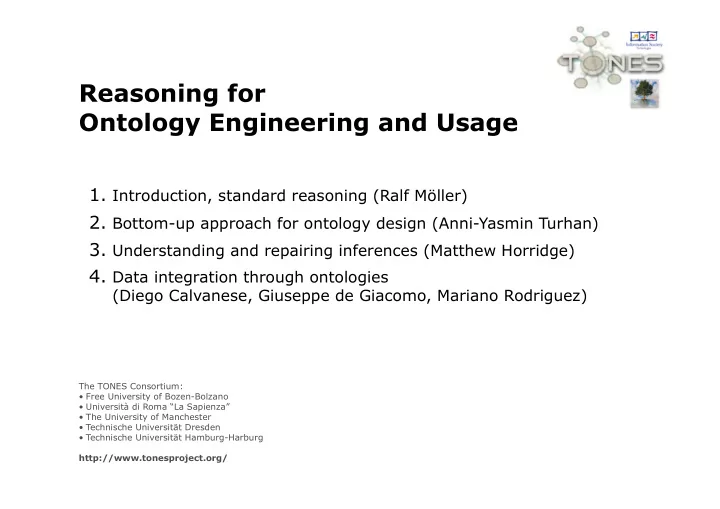

Reasoning for Ontology Engineering and Usage 1. Introduction, standard reasoning (Ralf Möller) 2. Bottom-up approach for ontology design (Anni-Yasmin Turhan) 3. Understanding and repairing inferences (Matthew Horridge) 4. Data integration through ontologies (Diego Calvanese, Giuseppe de Giacomo, Mariano Rodriguez) The TONES Consortium: • Free University of Bozen-Bolzano • Università di Roma “La Sapienza” • The University of Manchester • Technische Universität Dresden • Technische Universität Hamburg-Harburg http://www.tonesproject.org/
Reasoning for Ontology Engineering and Usage Part 1: Introduction Ralf Möller Hamburg University of Technology The TONES Consortium: • Free University of Bozen-Bolzano • Università di Roma “La Sapienza” • The University of Manchester • Technische Universität Dresden • Technische Universität Hamburg-Harburg http://www.tonesproject.org/
Terminological knowledge • Represent an application domain in terms of • Classes (concept descriptions), • Properties (relations, role descriptions), and • Objects (instances, individuals) • First step: select names (define signature) • Atomic concept descriptions: Student, Professor, Chair, Department, … • Atomic role descriptions: headOf, takesCourse, memberOf • Individuals: FullProfessor01, Department09, … • Use axioms to impose “constraints” (restrictions) on the interpretation of these names • A chair must be a person , • Persons are no departments Reasoning for Ontology Engineering and Usage Ralf Möller 3
Ontologies Ontology TBox - Class-level Reasoner ABox - Instance-level • Standardization of ontology languages • DL (abstract syntax), OWL 2 (and various sublanguages) • Standardization of query and manipulation languages • DIG 1.2, OWL API, OWLlink • Decision problems • Does the ontology make sense (satisfiability) • Find implicit terminology (e.g. subsumption) • Find implicit facts • Need reasoning for solving problems • Need optimized techniques to achieve scalability
Editing Ontologies Reasoning for Ontology Engineering and Usage Ralf Möller 5
Various approaches for design • Top-down, bottom-up, reuse, … Top-down ontology design Ontology TBox - Class-level Reasoner ABox - Instance-level Reasoning for Ontology Engineering and Usage Ralf Möller 6
Software infrastructure for ontology engineering • Standard Reasoning: • CEL, Fact++, Pellet, RacerPro • Non-Standard Reasoning: • Commonalities, Approximation, Matching, Modularization, Explanation • SONIC as a Racer plugin, Pellet Extensions • Ontology-based data access • RacerPro, QuOnto • User Interfaces: • RacerPorter (Tutorial Part 1) + SONIC plugin • Protégé + Plugins: • Racer plugin (Tutorial Part 1) • SONIC plugin (Tutorial Part 2) • Modularization plugin (Tutorial Part 3) • Explanation plugin (Tutorial Part 3) • OBDA plugin (Tutorial Part 4) Reasoning for Ontology Engineering and Usage Ralf Möller 7
OWL, a textual ontology language • Various syntaxes • OWL/XML syntax • RDF/XML syntax • Functional syntax(es) • Need to understand the semantics • Semantics based on description logics • Abstract syntax Reasoning for Ontology Engineering and Usage Ralf Möller 8
Representative DL: Reasoning for Ontology Engineering and Usage Ralf Möller 9
Example concept descriptions Reasoning for Ontology Engineering and Usage Ralf Möller 10
Reasoning for Ontology Engineering and Usage Ralf Möller 11
Reasoning for Ontology Engineering and Usage Ralf Möller 12
Reasoning for Ontology Engineering and Usage Ralf Möller 13
Functional style: Manchester Syntax Class: Person and (worksFor some Organization) OWL/XML Syntax <ox:Intersection> <ox:OWLClass ox:URI=“Person”> <ox:ObjectSomeValuesFrom> <ox:ObjectProperty ox:URI=“worksFor”/> <ox:OWLClass ox:URI=“Organization”/> <ox:ObjectSomeValuesFrom/> <ox:Intersection/> Reasoning for Ontology Engineering and Usage Ralf Möller 14
ALCQ Semantics Reasoning for Ontology Engineering and Usage Ralf Möller 15
Interpretation of concept descrs Person Person Person Person P1 P2 P3 P4 Sem DL DB Web Course Course Course
Satisfiability of concept descriptions Reasoning for Ontology Engineering and Usage Ralf Möller 17
Tbox Reasoning for Ontology Engineering and Usage Ralf Möller 18
Model of Tbox, Subsumption 19
Tbox inference problems Reasoning for Ontology Engineering and Usage Ralf Möller 20
ALC as a fragment of FOL • Concepts = unary predicates • Roles = binary predicates • Concept descriptions = FOL-formulae with one free variable • GCIs = FOL-formulae without free variables (sentences) • KB = set of sentences Reasoning for Ontology Engineering and Usage Ralf Möller 21
Classification Person Course Organization Student Department Professor Chair FullProfessor UndergraduateStudent Reasoning for Ontology Engineering and Usage Ralf Möller 22
Classification Person Course Organization Professor Student Department FullProfessor Chair UndergraduateStudent Reasoning for Ontology Engineering and Usage Ralf Möller 23
Demo • RacerPro and RacerPorter Reasoning for Ontology Engineering and Usage Ralf Möller 24
What about individuals? Chair(x) Ralf, Ian,... Querying Ontologies Ontology TBox - Class-level Reasoner ABox - Instance-level Reasoning for Ontology Engineering and Usage Ralf Möller 25
Abox Reasoning for Ontology Engineering and Usage Ralf Möller 26
Example Reasoning for Ontology Engineering and Usage Ralf Möller 27
Abox consistency Reasoning for Ontology Engineering and Usage Ralf Möller 28
Abox inference problems Reasoning for Ontology Engineering and Usage Ralf Möller 29
Ontology usage • Example: curriculum design Reasoning for Ontology Engineering and Usage Ralf Möller 30
Unique name assumption • Different individuals are mapped to different domain objects • Example: Reasoning for Ontology Engineering and Usage Ralf Möller 31
Example • Find eager students Reasoning for Ontology Engineering and Usage Ralf Möller 32
Open world assumption • If something cannot be proven, it is not concluded that the negation holds • Example: find lazy professors • Epistemic aspects in query languages required (e.g., nRQL) Reasoning for Ontology Engineering and Usage Ralf Möller 33
Query Answering Reasoning for Ontology Engineering and Usage Ralf Möller 34
Query answering w.r.t. ontologies • Incomplete information, but need the certain answers • Expressivity of different query languages • Grounded conjunctive queries plus additions • In principle: reduction to instance tests (standard service) • But: non-trivial optimization techniques required (e.g., query execution plans) • Efficient QA in practical applications for expr. DLs • Aggregation operators and • Server-side processing of query results with optimization • Practical implementation as part of RacerPro Reasoning for Ontology Engineering and Usage Ralf Möller 35
State of the Art Expressive DLs, answering GCQs • 5 years ago: 100 Individuals • 3 years ago: 1000 Individuals • Now: 10000 individuals, interactive queries, up to 100000 depending on the expressivity used in the Tbox • Note that we talk about sound and complete reasoning Reasoning for Ontology Engineering and Usage Ralf Möller 36
Recommend
More recommend